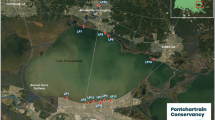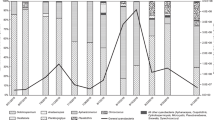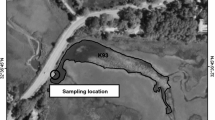Abstract
In late May 2016, a cyanobacterial harmful algal bloom (cHAB) was detected in the Maumee River, the largest tributary to Lake Erie, the southernmost lake of the Laurentian Great Lakes system. Testing on 31 May identified Planktothrix agardhii as the dominant cyanobacterium with cell abundance exceeding 1.7×109 cells/L and total microcystins (MC) reaching 19 μg/L MC-LR equivalents, a level over 10-fold higher than the 2015 revised U.S. Environmental Protection Agency (EPA) national health advisory levels for drinking water exposure to adults. Low river discharge coincident with negligible precipitation through the latter half of May coincided with an 80% decline in river turbidity that likely favored bloom formation by a low-light adapted P. agardhii population. Also contributing to the cHAB were high initial nutrient loads and an increase of the river temperature from 13°C to 26°C over this same period. The bloom persisted through 5 June with microcystins exceeding 22 μg/L MC-LR equivalents at the bloom peak. By 6 June, the river had returned to its muddy character following a rain event and sampling on 7 June detected only low levels of toxin (<0.6 μg/L) at public water systems located near the bloom origin. The elevated toxin production associated with this early onset bloom was without precedent for the Maumee River and an unique attribute of the cHAB was the high proportion of potentially-toxic genotypes. Whereas Planktothrix spp. is common in lotic environments, and has been previously detected in the Maumee, blooms are not commonly reported. This early onset, microcystin-producing cHAB provided a rare opportunity to glean insights into environmental factors that promote bloom development and dominance by Planktothrix in lotic environments.
Similar content being viewed by others
References
Acinas S G, Haverkamp T H, Huisman J, Stal L J. 2009. Phenotypic and genetic diversification of Pseudanabaena spp. (cyanobacteria). The ISME Journal, 3 (1): 31–46.
Allinger L E, Reavie E D. 2013. The ecological history of Lake Erie as recorded by the phytoplankton community. Journal of Great Lakes Research, 39 (3): 365–382.
Anagnostidis K, Komárek J. 1985. Modern approach to the classification system of cyanophytes. 1-Introduction. Algological Studies, 38–39: 291–302.
Anagnostidis K, Komárek J. 1988. Modern approach to the classification system of cyanophytes. 3-Oscillatoriales. Algological Studies, 50–53: 327–472.
Atkins R, Rose T, Brown R S, Robb M. 2001. The microcystis cyanobacteria bloom in the Swan River-February 2000. Water Science and Technology: A Journal of the International Association on Water Pollution Research, 43 (9): 107–114.
Berardo R, Formica F, Reutter J, Singh A. 2017. Impact of land use activities in the Maumee River watershed on harmful algal blooms in Lake Erie. Case Studies in the Environment, 1(1): 1–8. https://doi.org/10/1525/cse.2017.sc.450561.
Bertani I, Steger C E, Obenour D R, Fahnenstiel G L, Bridgeman T B, Johengen T H, Sayers M J, Shuchman R A., Scavia D. 2017. Tracking cyanobacteria blooms: do different monitoring approaches tell the same story? Science of the Total Environment, 575: 294–308.
Briand E, Gugger M, François J C, Bernard C, Humbert J F, Quiblier C. 2008a. Temporal variations in the dynamics of potentially microcystin-producing strains in a bloomforming Planktothrix agardhii (Cyanobacterium) population. Applied and Environmental Microbiology, 74 (12): 3 839–3 848.
Briand E, Yéprémian C, Humbert J F, Quiblier C. 2008b. Competition between microcystin-and non-microcystinproducing Planktothrix agardhii (Cyanobacteria) strains under different environmental conditions. Environmental Microbiology, 10 (12): 3 337–3 348.
Bridgeman T B, Chaffin J D, Kane D D, Conroy J D, Panek S E, Armenio P M. 2012. From River to Lake: phosphorus partitioning and algal community compositional changes in Western Lake Erie. Journal of Great Lakes Research, 38 (1): 90–97.
Bullerjahn G S, McKay R M, Davis T W, Baker D B, Boyer G L, D’Anglada L V, Doucette G J, Ho J C, Irwin E G, Kling C L, Kudela R M, Kurmayer R, Michalak A M, Ortiz J D, Otten T G, Paerl H W, Qin B Q, Sohngen B L, Stumpf R P, Visser P M, Wilhelm S W. 2016. Global solutions to regional problems: collecting global expertise to address the problem of harmful cyanobacterial blooms. A Lake Erie case study. Harmful Algae, 54: 223–238.
Chaffin J D, Bridgeman T B, Bade D L. 2013. Nitrogen constrains the growth of late summer cyanobacterial blooms in Lake Erie. Advances in Microbiology, 3 (6A): 37 926.
Chaffin J D, Sigler V, Bridgeman T B. 2014. Connecting the blooms: tracking and establishing the origin of the recordbreaking Lake Erie Microcystis bloom of 2011 using DGGE. Aquatic Microbial Ecology, 73 (1): 29–39.
Christiansen G, Molitor C, Philmus B, Kurmayer R. 2008. Nontoxic strains of cyanobacteria are the result of major gene deletion events induced by a transposable element. Molecular Biology and Evolution, 25 (8): 1 695–1 704.
Conroy J D, Kane D D, Briland R D, Culver D A. 2014. Systemic, early-season Microcystis blooms in western Lake Erie and two of its major agricultural tributaries (Maumee and Sandusky rivers). Journal of Great Lakes Research, 40 (3): 518–523.
Davis T W, Bullerjahn G S, Tuttle T, McKay R M, Watson S B. 2015. Effects of increasing nitrogen and phosphorus concentrations on phytoplankton community growth and toxicity during Planktothrix blooms in Sandusky Bay, Lake Erie. Environmental Science & Technology, 49 (12): 7 197–7 207.
DeSantis T Z, Hugenholtz P, Larsen N, Rojas M, Brodie E L, Keller K, Huber T, Dalevi D, Hu P, Andersen G L. 2006. Greengenes, a chimera-checked 16S rRNA gene database and workbench compatible with ARB. Applied and Environmental Microbiology, 72 (7): 5 069–5 072.
Foy R H, Gibson C E, Smith R V. 1976. The influence of daylength, light intensity and temperature on the growth rates of planktonic blue-green algae. British Phycological Journal, 11 (2): 151–163.
Harke M J, Steffen M M, Gobler C J, Otten T G, Wilhelm S W, Wood S A, Paerl H W. 2016. A review of the global ecology, genomics, and biogeography of the toxic cyanobacterium, Microcystis spp. Harmful Algae, 54: 4–20.
Havens K E, James R T, East T L, Smith V H. 2003. N: P ratios, light limitation, and cyanobacterial dominance in a subtropical lake impacted by non-point source nutrient pollution. Environmental Pollution, 122 (3): 379–390.
Hufford T L. 1965. A comparison of photosynthetic yields in the Maumee River, Steidtmann's Pond, and Urschel's Quarry under natural conditions. Ohio Journal of Science,65 (4): 176–182.
Illumina. 2014. Illumina 16S metagenomics sequencing workflow. 1270-2014-003-B, https://doi.org/support.illumina.com/content/dam/illumina-marketing/documents/products/other/16s-metagenomics-faq-1270-2014-003.pdf.
Klindworth A, Pruesse E, Schweer T, Peplies J, Quast C, Horn M, Glöckner F O. 2013. Evaluation of general 16S ribosomal RNA gene PCR primers for classical and nextgeneration sequencing-based diversity studies. Nucleic Acids Research, 41 (1): e1, https://doi.org/10.1093/nar/gks808.
Kurmayer R, Christiansen G, Fastner J, Börner T. 2004. Abundance of active and inactive microcystin genotypes in populations of the toxic cyanobacterium Planktothrix spp. Environmental Microbiology, 6 (8): 831–841.
Kutovaya O A, McKay R M L, Beall B F N, Wilhelm S W, Kane D D, Chaffin J D, Bridgeman T B, Bullerjahn G S. 2012. Evidence against fluvial seeding of recurrent toxic blooms of Microcystis spp. in Lake Erie’s western basin. Harmful Algae, 15: 71–77.
Maier H R, Burch M D, Bormans M. 2001. Flow management strategies to control blooms of the cyanobacterium, Anabaena circinalis, in the River Murray at Morgan, South Australia. River Research and Applications, 17 (6): 637–650.
McCarty C L, Nelson L, Eitniear S, Zgodzinski E, Zabala A, Billing L, DiOrio M. 2016. Community needs assessment after microcystin toxin contamination of a municipal water supply—Lucas County, Ohio, September 2014. MMWR. Morbidity and Mortality Weekly Report, 65 (35): 925–929.
McKay R M L, Geider R J, LaRoche J. 1997. Physiological and biochemical response of the photosynthetic apparatus of two marine diatoms to Fe stress. Plant Physiology, 114 (2): 615–622.
Michalak A M, Anderson E J, Beletsky D, Boland S, Bosch N S, Bridgeman T B, Chaffin J D, Cho K, Confesor R, Daloğlu I, DePinto J V, Evans M A, Fahnenstiel G L, He L L, Ho J C, Jenkins L, Johengen T H, Kuo K C, LaPorte E, Liu X J, McWilliams M R, Moore M R, Posselt D J, Richards R P, Scavia D, Steiner A L, Verhamme E, Wright D M, Zagorski M A. 2013. Record-setting algal bloom in Lake Erie caused by agricultural and meteorological trends consistent with expected future conditions. Proceedings of the National Academy of Sciences of the United States of America, 110 (16): 6 448–6 452.
Muenich R L, Kalcic M, Scavia D. 2016. Evaluating the impact of legacy P and agricultural conservation practices on nutrient loads from the Maumee River Watershed. Environmental Science & Technology, 50 (15): 8 146–8 154.
Munawar M, Munawar I F. 1976. A lakewide study of phytoplankton biomass and its species composition in Lake Erie, April–December 1970. Journal of the Fisheries Research Board of Canada, 33 (3): 581–600.
Murphy J, Riley J P. 1962. A modified single solution method for the determination of phosphate in natural waters. Analytica Chimica Acta, 27: 31–36.
Ohio EPA Division of Drinking and Ground Waters. 1999. State of Ohio source water assessment and protection program. https://doi.org/epa.ohio.gov/portals/28/documents/swap/swapdoc.pdf.
Ohio EPA Division of Environmental Services. 2015. Ohio EPA total (extracellular and intracellular) microcystins-ADDA by ELISA analytical methodology. Ohio EPA, Reynoldsburg, OH, November 2015, https://doi.org/epa.ohio.gov/Portals/28/documents/labcert/OhioEPADES701.0Version2.2.pdf.
Ostermaier V, Schanz F, Köster O, Kurmayer R. 2012. Stability of toxin gene proportion in red-pigmented populations of the cyanobacterium Planktothrix during 29 years of reoligotrophication of Lake Zürich. BMC Biology, 10: 100, https://doi.org/www.biomedcentral.com/1741-7007/10/100.
Paerl H W, Huisman J. 2008. Blooms like it hot. Science, 320(5872): 57–58.
Patton C J, Kryskalla J R. 2011. Colorimetric determination of nitrate plus nitrite in water by enzymatic reduction, automated discrete analyzer methods: U.S. Geological Survey Techniques and Methods, U.S. Geological Survey, Reston, VA. p.34.
Platt T, Gallegos C L, Harrison W G. 1980. Photoinhibition of photosynthesis in natural assemblages of marine phytoplankton. Journal of Marine Research, 38: 687–701.
Post A F, Loogman J G, Mur L R. 1985. Regulation of growth and photosynthesis by Oscillatoria agardhii grown with a light/dark cycle. FEMS Microbiology Letters, 31 (2): 97–102.
Reynolds C S. 2003. Pelagic community assembly and the habitat template. Bocconea, 16 (1): 323–339.
Richards R P, Baker D B, Crumrine J P, Stearns A M. 2010. Unusually large loads in 2007 from the Maumee and Sandusky Rivers, tributaries to Lake Erie. Journal of Soil and Water Conservation, 65 (6): 450–462.
Rücker J, Wiedner C, Zippel P. 1997. Factors controlling the dominance of Planktothrix agardhii and Limnothrix redekei in eutrophic shallow lakes. Hydrobiologia, 342–343: 107–115.
Scavia D, Allan J D, Arend K K, Bartell S, Beletsky D, Bosch N S, Brandt S B, Briland R D, Daloğlu I, DePinto J V, Dolan D M, Evans M A, Farmer T M, Goto D, Han H, Höök T O, Knight R, Ludsin S A, Mason D, Michalak A M, Peter R R, Roberts J J, Rucinski D K, Rutherford E, Schwab D J, Sesterhenn T M, Zhang H Y, Zhou Y T. 2014. Assessing and addressing the re-eutrophication of Lake Erie: central basin hypoxia. Journal of Great Lakes Research, 40 (2): 226–246.
Scheffer M, Rinaldi S, Gragnani A, Mur L R, van Nes E H. 1997. On the dominance of filamentous cyanobacteria in shallow, turbid lakes. Ecology, 78 (1): 272–282.
Steffen M M, Belisle B S, Watson S B, Boyer G L, Wilhelm S W. 2014. Status, causes and controls of cyanobacterial blooms in Lake Erie. Journal of Great Lakes Research, 40 (2): 215–225.
Steffen M M, Davis T W, McKay R M L, Bullerjahn G S, Krausfeldt L E, Stough J M A, Neitzey M L, Gilbert N E, Boyer G L, Johengen T H, Gossiaux D C, Burtner A M, Palladino D, Rowe M D, Dick G J, Meyer K A, Levy S, Boone B E, Stumpf R P, Wynne T T, Zimba P V, Gutierrez D, Wilhelm S W. 2017. Ecophysiological examination of the Lake Erie Microcystis bloom in 2014: linkages between biology and the water supply shutdown of Toledo, OH. Environmental Science & Technology, 51 (12): 6 745–6 755.
Stow C A, Cha Y, Johnson L T, Confesor R, Richards R P. 2015. Long-term and seasonal trend decomposition of Maumee River nutrient inputs to western Lake Erie. Environmental Science & Technology, 49 (6): 3 392–3 400.
U. S. Geological Survey. 2015. National field manual for the collection of water-quality data: U.S. Geological Survey Techniques of Water-Resources Investigations, book 9. Chapters A1–A10, https://doi.org/pubs.water.usgs.gov/twri9A.
Van den Wyngaert S, Salcher M M, Pernthaler J, Zeder M, Posch T. 2011. Quantitative dominance of seasonally persistent filamentous cyanobacteria (Planktothrix rubescens) in the microbial assemblages of a temperate lake. Limnology and Oceanography, 56 (1): 97–109.
Verduin J. 1959. Photosynthesis by aquatic communities in northwestern Ohio. Ecology, 40 (3): 377–383.
Wagner R J, Boulger Jr R W, Oblinger C J, Smith B A. 2006. Guidelines and standard procedures for continuous waterquality monitors: Station operation, record computation, and data reporting. Techniques and Methods 1–D3, p.51, https://doi.org/pubs.water.usgs.gov/tm1d3.
Wang Q, Garrity G M, Tiedje J M, Cole J R. 2007. Naive Bayesian classifier for rapid assignment of rRNA sequences into the new bacterial taxonomy. Applied and Environmental Microbiology, 73 (16): 5 261–5 267.
Watson S B, Miller C, Arhonditsis G, Boyer G L, Carmichael W, Charlton M N, Confesor R, Depew D C, Höök T O, Ludsin S A, Matisoff G, McElmurry S P, Murray M W, Richards R P, Rao Y R, Steffen M M, Wilhelm S W. 2016. The re-eutrophication of Lake Erie: harmful algal blooms and hypoxia. Harmful Algae, 56: 44–66.
Webster I T, Sherman B S, Bormans M, Jones G. 2000. Management strategies for cyanobacterial blooms in an impounded lowland river. Regulated Rivers: Research & Management, 16 (5): 513–525.
Welschmeyer N A. 1994. Fluorometric analysis of chlorophyll a in the presence of chlorophyll b and pheopigments. Limnology and Oceanography, 39(8): 1 985–1 992.
Xia J, Cheng S B, Hao X P, Xia R, Liu X J. 2010. Potential impacts and challenges of climate change on water quality and ecosystem: case studies in representative rivers in China. Journal of Resources and Ecology, 1 (1): 31–35.
Xia R, Chen Z, Zhou Y. 2012. Impact assessment of climate change on algal blooms by a parametric modeling study in Han River. Journal of Resources and Ecology, 3 (3): 209–219.
Znachor P, Nedoma J. 2010. Importance of dissolved organic carbon for phytoplankton nutrition in a eutrophic reservoir. Journal of Plankton Research, 32 (3): 367–376.
Zotina T, Köster O, Jüttner F. 2003. Photoheterotrophy and light-dependent uptake of organic and organic nitrogenous compounds by Planktothrix rubescens under low irradiance. Freshwater Biology, 48 (10): 1 859–1 872.
Zwart G, Kamst-van Agterveld M P, Van Der Werff-Staverman I, Hagen F, Hoogveld H L, Gons H J. 2005. Molecular characterization of cyanobacterial diversity in a shallow eutrophic lake. Environmental Microbiology, 7 (3): 365–377.
Acknowledgement
The authors thank Heather Raymond, State HAB Coordinator for Ohio EPA for alerting us to the Maumee River cHAB described in this contribution. Thanks are also extended to Scott Hoover and Jeff Weis of the City of Napoleon and Donna Francy of the USGS Michigan-Ohio Water Science Center for their assistance providing data from the Maumee River. Chaoxuan Guo (Nanjing Institute of Geography and Limnology) shared helpful information regarding recent cHABs in Chinese rivers. Ben Beall contributed the map showing sampling sites. The manuscript also benefitted from helpful comments of two anonymous reviewers.
Author information
Authors and Affiliations
Corresponding author
Additional information
Supported by a Harmful Algal Bloom Research Initiative Grant (No. R/HAB-2-ODHE) from the Ohio Department of Higher Education (GSB, RMLM) and Ohio Sea Grant College Program grant R/ER-114 (GSB, RMLM)
Rights and permissions
About this article
Cite this article
Mckay, R.M.L., Tuttle, T., Reitz, L.A. et al. Early onset of a microcystin-producing cyanobacterial bloom in an agriculturally-influenced Great Lakes tributary. J. Ocean. Limnol. 36, 1112–1125 (2018). https://doi.org/10.1007/s00343-018-7164-z
Received:
Accepted:
Published:
Issue Date:
DOI: https://doi.org/10.1007/s00343-018-7164-z




